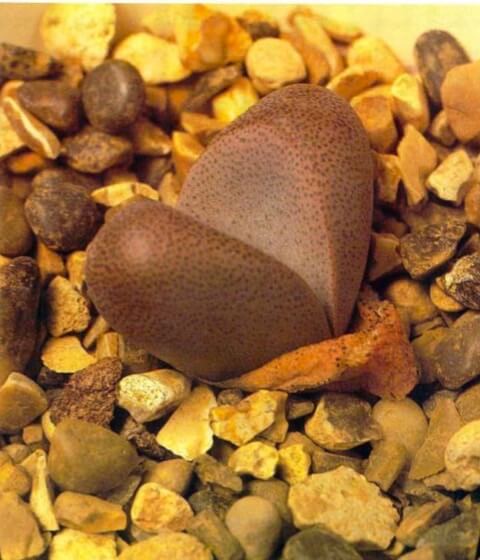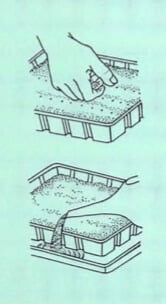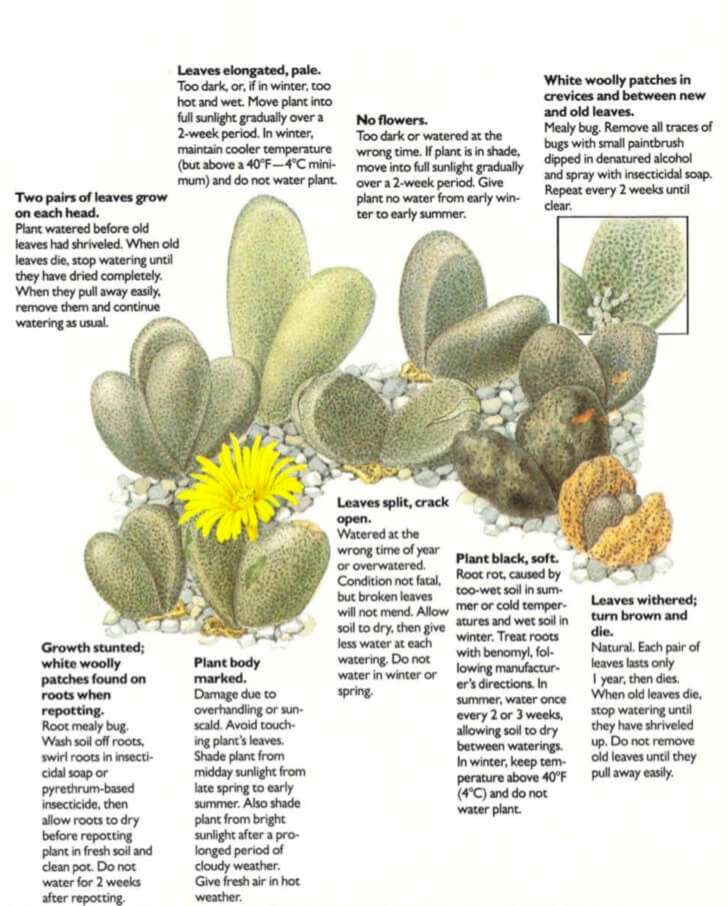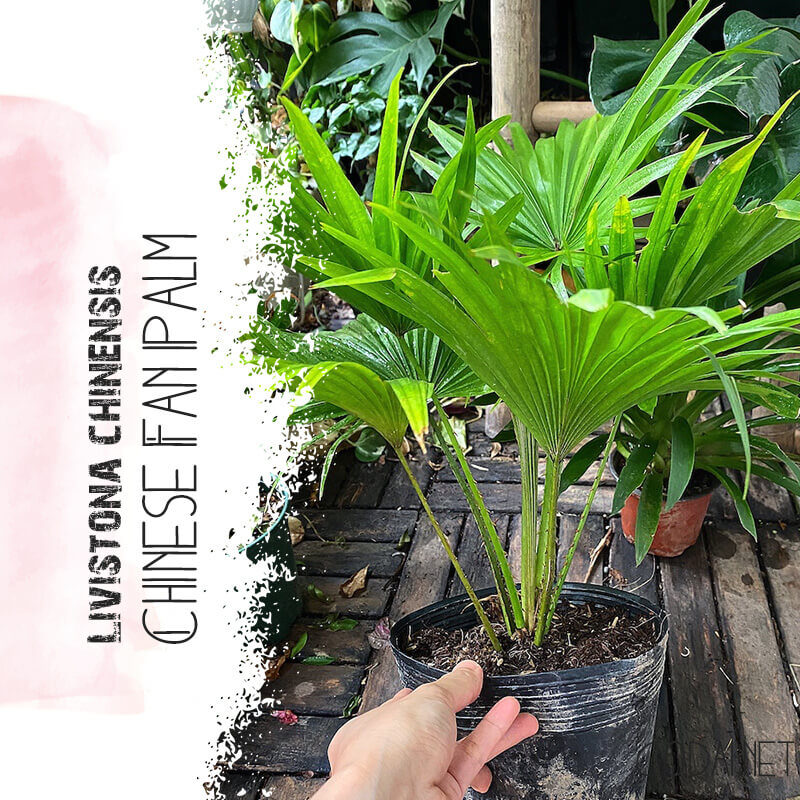Tổng số phụ: 49,000₫
[Ebook Việt Hoá] The Instant Guide to Healthy Houseplants (Hướng dẫn tức thời để chăm cây trong nhà khoẻ mạnh), Chi Pleiospilos
[Ebook Việt Hoá] The Instant Guide to Healthy Houseplants: Pleiospilos (Living rock, Mimicry plant)
- Nguồn: [Ebook Việt Hoá] The Instant Guide to Healthy Houseplants (Hướng dẫn tức thời để chăm cây trong nhà khoẻ mạnh)
- Biên tập: Dũng Cá Xinh
- Biên dịch: Team Codai.net
English
One of the South Mrican plants that mimic stones, Pleiospilos is similar to Lithops except that it resembles pieces of broken, weathered gray rock instead of smooth pebbles. The swollen leaves of the living rock plant are about 2 inches (5 cm) high and 2 1/2 inches (6 cm) across. Plants sometimes grow in clumps, but single 2- or 3-headed plants are most common. Bright yellow flowers appear from between the thick leaves in late summer. Other species include Pleiospilos boluisi, gray and angular; P. nelii, rounded, gray-brown; P. willowmorensis, with longer leaves than most; P. prismaticus; and P. simulans.

Light
Needs bright light such as found in a sunny windowsill but must be protected from mid- day sunlight in spring and early summer. Following a period of cloudy weather, shade the plant from full sunlight until it is reacclimated.
Temperature
Keep temperature above 40°F (4°C). Provide fresh air during hot weather.
Soil
Use one part loam-based pot- ting soil or soilless mix and one part coarse, gritty sand.
Feeding
Feeding is not necessary if plant has been repotted within the past 3 years. If it has not, apply high-potash fertilizer twice during the summer.
Water
Follow watering regimen carefully, or plant’s leaves may split or rot. Water every 2 or 3 weeks beginning in early summer, allOWing soil to dry between waterings. Taper off frequency of watering in fall. When old leaves die, stop watering plant until they have shriveled up completely; when they pull away easily, remove them and continue watering plant as usual. Do not water plant from early winter through late spring.
Repotting
When plant is young, repot annually in late spring. After 3 years, repot every other year. Do not water for 2 weeks after repotting.
Propagation
Propagation is best from seed, but old clumps may be propagated by cuttings.
Growing from seed
- 1. Sow seed thinly in spring on surface of prepared tray or half pot. Tap sides of tray to settle seed.
- 2. Water from base with fungicide diluted as for ‘damping off (see Glossary) of seedlings, until surface of soil is damp. Place tray or pot in clear plastic bag with ends folded underneath to seal in moisture. Leave tray in bright light (but not direct sunlight) at 70°F(21 °C).

What Goes Wrong

- Two pairs of leaves grow on each head: Plant watered before old leaves had shriveled. When old leaves die, stop watering until they have dried completely. When they pull away easily, remove them and continue watering as usual.
- Growth stunted: white woolly patches found on roots when repotting: Root mealy bug. Wash soil off roots, swirl roots in insecticidal soap or pyrethrum-based insecticide, then allow roots to dry before repotting plant in fresh soil and clean pot Do not water fo; 2 weeks after repotting.
- Plant body marked: Damage due to overhandling or sunscald. Avoid touching plant’s leaves. Shade plant from midday sunlight from late spring to early summer. Also shade plant from bright sunlight after a pro- longed period of cloudy weather. Give fresh air in hot weather
- Leaves split, crack open: Watered at the wrong time of year or overwatered. Condition not fatal, but broken leaves will not mend. Allow soil to dry, then give less water at each watering. Do not water in winter or spring.
- Plant black, soft: Root rot, caused by too-wet soil in summer or cold temperatures and wet soil in winter. Treat roots with benomyl, following manufacturer’s directions. In summer, water once every 2 or 3 weeks, allowing soil to dry between waterings. In winter, keep tem- perature above 40°F WC) and do not water plant.
- Leaves withered; turn brown and die: Natural. Each pair of leaves lasts only 1 year, then dies. When old leaves die, stop watering until they have shriveled up. Do not remove old leaves until they pull away easily.
- Leaves elongated, pale: Too dark, or, if in winter, too hot and wet. Move plant into full sunlight gradually over a 2-week period. In winter, maintain cooler temperature (but above a 40°F 4°C minimum) and do not water plant.
- No flowers: Too dark or watered at the wrong time. If plant is in shade, move into full sunlight gradually over a 2-week period. Give plant no water from early winter to early summer.
- White woolly patches in crevices and between new and old leaves: Mealy bug. Remove all traces of bugs with small paintbrush dipped in denatured alcohol and spray with insecticidal soap. Repeat every 2 weeks until clear.
Tiếng Việt
Một trong những loài thực vật Nam Mỹ mô phỏng đá, Pleiospilos tương tự như cây Lithops ngoại trừ việc nó giống những mảnh đá xám bị phong hóa, bị vỡ thay vì những viên sỏi nhẵn. Lá của cây đá sống cao khoảng 2 inch (5 cm) và ngang 2 1/2 inch (6 cm). Cây đôi khi mọc thành cụm, nhưng cây đơn 2 hoặc 3 đầu là phổ biến nhất. Những bông hoa màu vàng tươi xuất hiện từ giữa những chiếc lá dày vào cuối mùa hè. Các loài khác bao gồm Pleiospilos boluisi, màu xám và góc cạnh; P. nelii, tròn, nâu xám; P. willowmorensis, với các lá dài hơn hầu hết các loại; P. prismaticus; và P. simulans.

Ánh sáng
Cần ánh sáng rực rỡ như ở bệ cửa sổ đầy nắng nhưng phải được bảo vệ khỏi ánh nắng giữa trưa vào mùa xuân và đầu mùa hè. Sau một khoảng thời gian trời nhiều mây, che nắng cho cây cho đến khi cây thích nghi trở lại.
Nhiệt độ
Giữ nhiệt độ trên 40 ° F (4 ° C). Cung cấp không khí trong lành khi thời tiết nắng nóng.
Đất
Sử dụng một phần đất pha mùn hoặc hỗn hợp không dính đất và một phần cát thô, sạn.
Bón phân
Không cần bón phân nếu cây đã được thay chậu trong vòng 3 năm qua. Nếu không, hãy bón phân có hàm lượng kali cao hai lần vào mùa hè.
Nước
Tuân thủ chế độ tưới nước cẩn thận, nếu không lá cây có thể bị tách hoặc thối. Tưới nước 2 hoặc 3 tuần một lần vào đầu mùa hè, để đất khô giữa các lần tưới. Giảm tần suất tưới vào mùa thu. Khi lá già chết, ngừng tưới cây cho đến khi lá héo hẳn; khi chúng rụng, hãy nhặt ra và tiếp tục tưới cây như bình thường. Không tưới cây từ đầu mùa đông đến cuối mùa xuân.
Thay chậu
Khi cây còn nhỏ, thay chậu hàng năm vào cuối mùa xuân. Sau 3 năm, thay chậu cách năm. Không tưới nước trong vòng 2 tuần sau khi thay chậu.
Nhân giống
Nhân giống tốt nhất là từ hạt, nhưng các khóm già có thể được nhân giống bằng cách giâm cành.
Trồng từ hạt giống
- 1. Gieo hạt mỏng vào mùa xuân trên bề mặt khay hoặc nửa chậu đã chuẩn bị. Gõ nhẹ vào các mặt của khay để lắng hạt.
- 2. Tưới nước từ gốc với thuốc diệt nấm được pha loãng vì sẽ có mầm bệnh (xem Chú giải thuật ngữ) trong cây giống, cho đến khi bề mặt đất ẩm. Đặt khay hoặc chậu vào túi nhựa trong với các đầu được gấp lại bên dưới để giữ ẩm. Để khay ở nơi có ánh sáng chói (nhưng không phải ánh nắng trực tiếp) ở 70 ° F (21 ° C).

Những vấn đề có thể xảy ra

- Mỗi đầu mọc hai cặp lá: Cây được tưới nước trước khi lá già héo. Khi lá già chết, ngừng tưới cho đến khi khô hẳn. Khi chúng rụng, hãy nhặt ra và tiếp tục tưới cây như bình thường.
- Sinh trưởng còi cọc; có những mảng lông tơ màu trắng trên rễ khi thay chậu: Rệp sáp. Rửa sạch đất khỏi rễ, xoáy rễ trong xà phòng diệt côn trùng hoặc thuốc trừ sâu pyrethrum, sau đó để cho rễ khô trước khi thay vào đất sạch và chậu sạch Không tưới nước 2 tuần sau khi thay chậu.
- Thân cây có dấu hiệu lạ: Thiệt hại do xử lý quá mức hoặc bị cháy nắng. Tránh chạm vào lá cây. Che bóng cho cây khỏi ánh nắng giữa trưa từ cuối mùa xuân đến đầu mùa hè. Cũng nên che bóng cho cây khỏi ánh nắng chói chang sau thời gian nhiều mây kéo dài. Cung cấp không khí trong lành trong thời tiết nắng nóng.
- Lá chẻ ngọn, nứt nẻ: Tưới không đúng thời điểm trong năm hoặc tưới quá nhiều. Tình trạng không tránh được, nhưng lá gãy sẽ không hàn gắn được. Để cho đất khô, sau đó cho ít nước vào mỗi lần tưới. Không tưới vào mùa đông hoặc mùa xuân.
- Cây bị đen, mềm: Bệnh thối rễ, do đất quá ẩm ướt vào mùa hè hoặc nhiệt độ lạnh và đất ẩm ướt vào mùa đông. Xử lý rễ bằng benomyl, theo hướng dẫn của nhà sản xuất. Vào mùa hè, tưới nước 2 hoặc 3 tuần một lần, để đất khô giữa các lần tưới. Vào mùa đông, giữ nhiệt độ trên 40 ° F (4 ° C) và không tưới cây.
- Lá héo úa; chuyển sang màu nâu và chết: Tự nhiên. Mỗi cặp lá chỉ tồn tại được 1 năm, sau đó sẽ chết. Khi lá già chết, ngừng tưới nước cho đến khi lá héo lại. Không loại bỏ lá già cho đến khi chúng tự rụng.
- Lá dài, nhợt nhạt: Quá tối, hoặc nếu vào mùa đông, quá nóng và ẩm ướt. Chuyển dần cây ra nơi có ánh nắng đầy đủ trong khoảng thời gian 2 tuần. Vào mùa đông, duy trì nhiệt độ mát hơn (nhưng trên 40 ° F tối thiểu 4 ° C) và không tưới cây.
- Không có hoa: Quá tối hoặc tưới không đúng thời điểm. Nếu cây ở trong bóng râm, hãy chuyển dần ra nơi có ánh nắng đầy đủ trong khoảng thời gian 2 tuần. Không tưới nước cho cây từ đầu mùa đông đến đầu mùa hè.
- Các mảng lông tơ màu trắng ở các kẽ hở và giữa các lá mới và già: Rệp sáp. Loại bỏ tất cả các dấu vết của bọ bằng cọ nhỏ nhúng vào cồn biến tính và xịt xà phòng diệt côn trùng. Lặp lại 2 tuần một lần cho đến khi khỏi hẳn.
 Cây Livistona chinensis Chinese Fan Palm (Cọ Quạt Mini) bầu nhựa đen
Cây Livistona chinensis Chinese Fan Palm (Cọ Quạt Mini) bầu nhựa đen ![[Ebook Việt Hoá] The Instant Guide to Healthy Houseplants: Pleiospilos (Living rock, Mimicry plant) [Ebook Việt Hoá] The Instant Guide to Healthy Houseplants: Pleiospilos (Living rock, Mimicry plant)](https://vn1.vdrive.vn/codai.net/2020/02/ebook-huong-dan-tuc-thoi-cham-cay-trong-nha-khoe-manh-116-pleiospilos.jpg)


